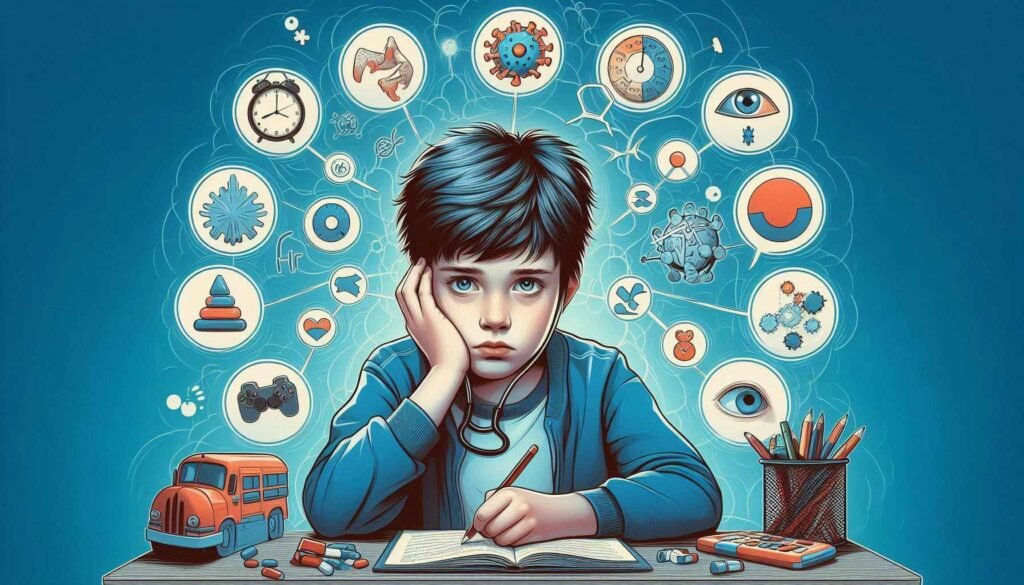
Signs of ADHD in Children: Early Detection and Treatment
Attention-Deficit/Hyperactivity Disorder (ADHD) is a common neurodevelopmental disorder that affects millions of children worldwide. The disorder often manifests as difficulties with maintaining attention, excessive hyperactivity, and impulsive behaviors. Early detection of ADHD is critical to ensure the child receives appropriate interventions and support, which can greatly improve their quality of life, both academically and socially. This guide will help parents and caregivers understand the key signs of ADHD, the importance of early detection, and the best treatment options available.
What is ADHD?
ADHD stands for Attention-Deficit/Hyperactivity Disorder, and it impacts a child’s ability to focus, regulate their energy levels, and control impulsive behaviors. Typically diagnosed before the age of 12, ADHD presents in three different forms:
- Predominantly Inattentive Presentation: Children with this subtype have significant difficulties focusing, organizing tasks, and paying attention.
- Predominantly Hyperactive-Impulsive Presentation: This type is marked by excessive movement, impulsive actions, and difficulty staying seated.
- Combined Presentation: This is the most common type, where children display both inattentive and hyperactive behaviors.
Children with ADHD often struggle academically, socially, and emotionally. Recognizing these signs early can significantly improve the management of ADHD symptoms through appropriate interventions.
Recognizing the Signs of ADHD in Children
Identifying ADHD in children can be tricky, as the symptoms may be mistaken for typical childhood behaviors. However, persistent patterns of inattentiveness, hyperactivity, and impulsivity across multiple environments (such as home and school) may suggest the presence of ADHD.
Inattention Symptoms
Children with the inattentive subtype of ADHD exhibit some of the following behaviors:
- Difficulty focusing on tasks or play activities: This may become evident in school, where tasks require sustained mental effort.
- Frequent careless mistakes: These children may make simple errors that could easily be avoided if they were paying closer attention.
- Trouble following instructions: They may start tasks but struggle to complete them due to their inability to focus.
- Forgetfulness and disorganization: These children often lose items necessary for tasks, such as homework or school supplies.
While all children may show these behaviors occasionally, children with ADHD struggle with them persistently. Their inattention often hinders their ability to function in everyday situations like schoolwork and social interactions.
Hyperactivity Symptoms
Hyperactive children are often:
- Constantly in motion: They may fidget, tap their hands, or squirm in their seats.
- Unable to play quietly: Structured play can be difficult, as they often exhibit excessive talking or noise-making.
- Prone to running or climbing in inappropriate settings: These children often seem to be driven by an “internal motor,” unable to sit still even in situations that demand calmness, like class or dinner time.
Impulsivity Symptoms
Children with impulsivity problems may:
- Interrupt others frequently: Whether it’s conversations or group activities, they find it hard to wait their turn.
- Act without thinking: This might lead to accidents or conflicts, as they may do something immediately without considering the consequences.
- Struggle with patience: Games, waiting in lines, or any activity requiring delayed gratification can become particularly challenging.
Early Detection and Diagnosis
Why Early Detection Matters
The earlier ADHD is identified, the sooner treatment and management strategies can be implemented. This early intervention can help prevent further difficulties, such as poor academic performance or social isolation. Since ADHD symptoms tend to worsen as school demands increase, early diagnosis allows children to receive the appropriate support during their formative years.
Steps for Diagnosing ADHD
Diagnosing ADHD involves multiple stages and requires a thorough evaluation from healthcare professionals, including pediatricians and child psychologists. The process typically includes:
- Parent and Teacher Reports: Doctors may request information from those who interact with the child regularly, such as parents and teachers. They provide valuable insights into the child’s behavior across different environments.
- Behavioral Assessments: Various ADHD screening tools, like the Vanderbilt Assessment Scale, help clinicians evaluate the severity and consistency of ADHD symptoms.
- Medical Examination: It’s essential to rule out other medical conditions that may mimic ADHD, such as hearing or vision problems, learning disabilities, or even sleep disorders.
- Observation: In some cases, the child’s behavior may be observed in different settings (home, school, playgroups) to see how they react to various stimuli and environments.
Treatment Options for ADHD
While ADHD cannot be cured, it can be effectively managed through a combination of therapy, medication, and support from parents and educators.
1. Behavioral Therapy
Behavioral therapy is often recommended as the first line of treatment, especially for young children. It helps the child learn how to regulate their behavior, and it also provides strategies for parents and teachers to create a more supportive environment. Techniques include:
- Parent Training: Parents learn how to implement structured routines, positive reinforcement, and clear consequences for behavior. This consistent approach at home can significantly improve the child’s ability to manage ADHD symptoms.
- Behavioral Classroom Interventions: Teachers may introduce strategies like breaking down tasks into smaller, manageable steps or giving the child regular breaks during long activities.
2. Medication
Medication, particularly stimulants like methylphenidate (Ritalin) or amphetamines (Adderall), is commonly prescribed for children with ADHD. These drugs help reduce hyperactivity and improve attention by increasing the levels of certain neurotransmitters in the brain. Non-stimulant medications such as atomoxetine are also used, particularly if stimulants aren’t effective or cause side effects.
It’s important for parents to work closely with healthcare providers to monitor their child’s response to medication, as finding the right dosage and type can take time.
3. Educational Support
Children with ADHD often require accommodations in school to help them meet academic expectations. This might involve:
- Individualized Education Programs (IEP): Under federal law, children with ADHD who meet specific criteria may receive specialized education services. This could include personalized learning goals and one-on-one support.
- 504 Plans: For children who do not qualify for an IEP, a 504 Plan can still provide important classroom accommodations, such as extra time on tests or modified homework assignments.
Supporting Children with ADHD at Home and School
At Home
Parents play a critical role in helping children with ADHD manage their symptoms. Establishing structure and consistency is essential. Here are some tips:
- Create a predictable routine: Having regular meal times, homework time, and bedtime routines can help children feel more secure.
- Break tasks into smaller steps: A large task may overwhelm a child with ADHD, so breaking it into smaller, more manageable pieces can make the task seem less daunting.
- Use positive reinforcement: Rewarding good behavior, even with small rewards like praise, can motivate the child to keep working towards better behavior.
At School
Teachers and school administrators can support children with ADHD by:
- Providing frequent breaks: Movement helps hyperactive children focus better when they return to their desks.
- Offering visual aids and reminders: Visual cues like checklists can help children stay on track during tasks.
Conclusion
ADHD can be a challenging condition, both for the children who live with it and for their families. However, with early detection, proper diagnosis, and a multi-faceted treatment plan, children with ADHD can thrive academically, socially, and emotionally. Parents, educators, and healthcare providers must work together to ensure these children receive the support they need to navigate the complexities of ADHD and reach their full potential. By staying informed and proactive, parents can help set their children on a path to success.



